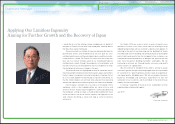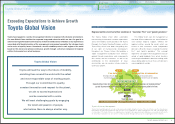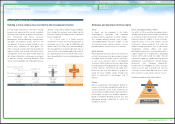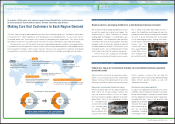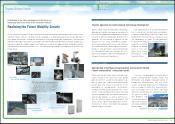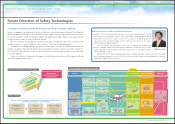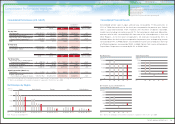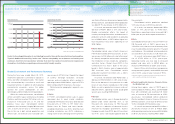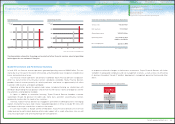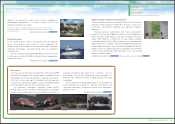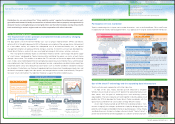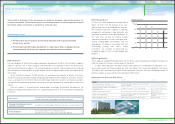Toyota 2011 Annual Report Download - page 17
Download and view the complete annual report
Please find page 17 of the 2011 Toyota annual report below. You can navigate through the pages in the report by either clicking on the pages listed below, or by using the keyword search tool below to find specific information within the annual report.
Integrated Safety Management Concept
Parking
Back Guide Monitor
Providing information and support Accident warning and avoidance Damage mitigation Passenger protection Emergency response
Radar Cruise Control
VDIM
Brake Assist
VSC
ABS
Lane Keeping Assist
Blind Corner Monitor
Night View
Lane Departure Warning
Distance Warning
Vehicle-Infrastructure
Cooperative System
Frontal Pre-Collision
System with
Pedestrian Detection
Rear-End Pre-Collision
System
HELPNET
Pedestrian
Injury- Reducing Body
Network-Linked
Navigation System
AFS
Intelligent
Parking Assist
Active Safety
Pre-Crash Safety
Passive Safety Rescue
Collision
G-BOOK G-Link
Seatbelts Airbags
Special FeatureMessage/Vision
Business and
Performance Review
Management and
Corporate Information
Financial Section and
Investor Information
Future Direction of Safety Technologies
Customers can feel good about driving and riding in Toyota’s vehicles
Toyota is engaged in developing both active and passive safety technologies, based on the Integrated
Safety Management Concept, so as to achieve the future mobility society’s ultimate goal of zero casualties
from traffic accidents. Under the Integrated Safety Management Concept, Toyota is pursuing safety by
linking the various safety systems installed in vehicles.
We also intend to secure product safety by thoroughly incorporating data from simulation and
accident analyses, as well as feedback from customers, in our technology development.
In addition to the reliability design that Toyota has focused on until now for reliable products that are
durable, we are pursuing safety design which aims to avoid occurrance of safety issues when malfunctions
occur in the vehicles or when our customers drive the vehicles and such design that takes into consideration
customers feelings.
Toyota will continue to develop technologies and work to provide solutions with the goal of offering
the world’s highest level of safety.
Active Safety
Passive Safety
Product Safety
Integrated Safety
Management Concept
Automotive Technologies
Designed to
Achieve Zero Injuries
and Fatalities
Direction of Future Safety Technologies
Ensure safety and peace of mind by reflecting benchmarking and
customer information in development
Safety
Design that does not
cause safety issues
regardless of customer
usage/operation
Peace of Mind
Design taking
customer
psychology into
account
Reliability
Design difficult to
fail/break
Product Safety
On April 1, 2011, Toyota created the position of chief safety technology officer (CSTO)
to comprehensively coordinate Toyota’s safety technologies and appointed Managing
Officer Moritaka Yoshida to the post. The aim of this position is to speed up decision
making and further strengthen global external communication abilities in the field of
vehicle safety technology development.
The CSTO handles the following four main issues: 1) Propose and arrange safety
policies; 2) Promote vehicle safety technology development; 3) Coordinate external safety-
related explanations and technology information; and 4) Act as a spokesperson about
safety technological aspects.
Although the CSTO is Toyota’s representative for our technological progress and enhancement at the global
safety technology and policy level, the CQOs (Chief Quality Officers), who were newly appointed last year, are
responsible for regional quality control.
Placement of a CSTO for vehicle development
Managing Officer, CSTO
Moritaka Yoshida
Special Feature: Toyota’s Safety Technology
0819
Toyota’s Safety Technology
17TOYOTA ANNUAL REPORT 2011


